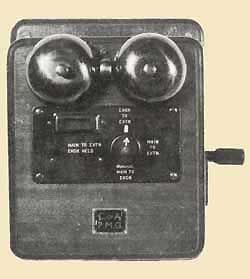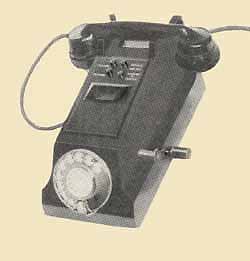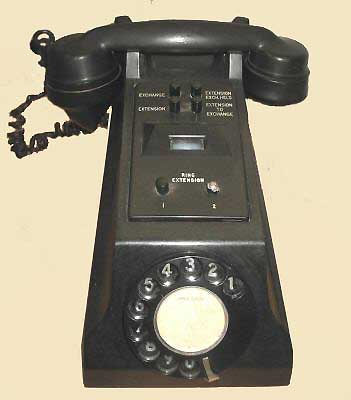| |||||
IntercomsThe APO did not have a large product line of intercoms. Most of the market seemed to be satisifed with manual switchboards, and given the amount of cabling needed for the early intercoms this is not surprising. By the end of the APO the newest intercom designs still dated from the 1920s. It should be pointed out, though, that most were so reliable in service that they were still being retired well into the 1980s.
Left: CB extension switch. This could be associated with any other telephone. The magneto was used to signal the extension.It was also known as the Junction Switch and Bell (JS&B). One exchange line, one extension phone. Right: Early Western Electric magneto version with drop shutter instead of visual indicator in the window.
Left: Teleintermediate with generator signalling. Also one line, one extension phone. A later version offered push button signalling. The signalling buttons were mounted at the front of the top panel. Centre: Extension phone. This model is confusing to collectors as it has both a dial and a generator. A similar phone was used on party lines on automatic exchanges. Right: A later version with push button signalling had a "RING" button inserted at the top in front of the handset or, as shown, on the lower front of the faceplate.
Teleintermediate, Generator signalling, late version. It used the same extension phone as shown above.
Left: A5 Intercom system, dating from the 1920s. One line , five internal extensions, one external 2-wire extension. Centre: A10 Intercom system, two exchange lines, ten internal extensions, one external two-wire extension. Right: Transfer Unit for the A10, incorporating buzzers and eyeball indicators for incoming calls and switches for night service. These phones were modernised somewhat in the 1950s by being issued in grey as well as black. This did not help - they were still ugly. Over the years parts were mixed in an attempt to keep the units in service a little longer, and hybrid units are common. These were unfortunately even uglier.
Left: Transfer Unit 1B Right: Transfer Unit 2A These were the early versions of the A5 and A10 transfer units.
| |||||











